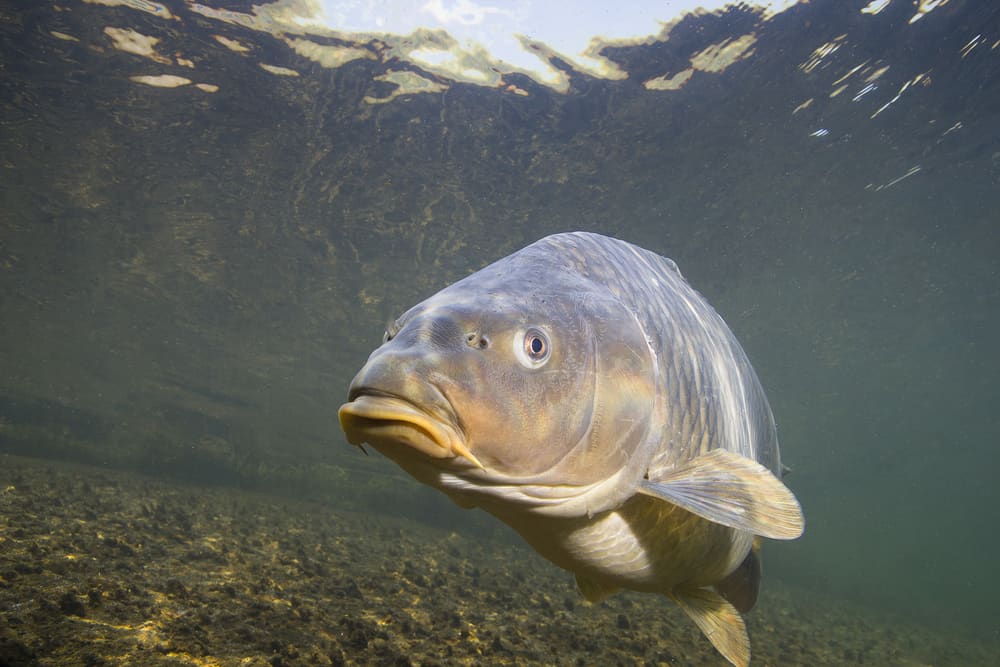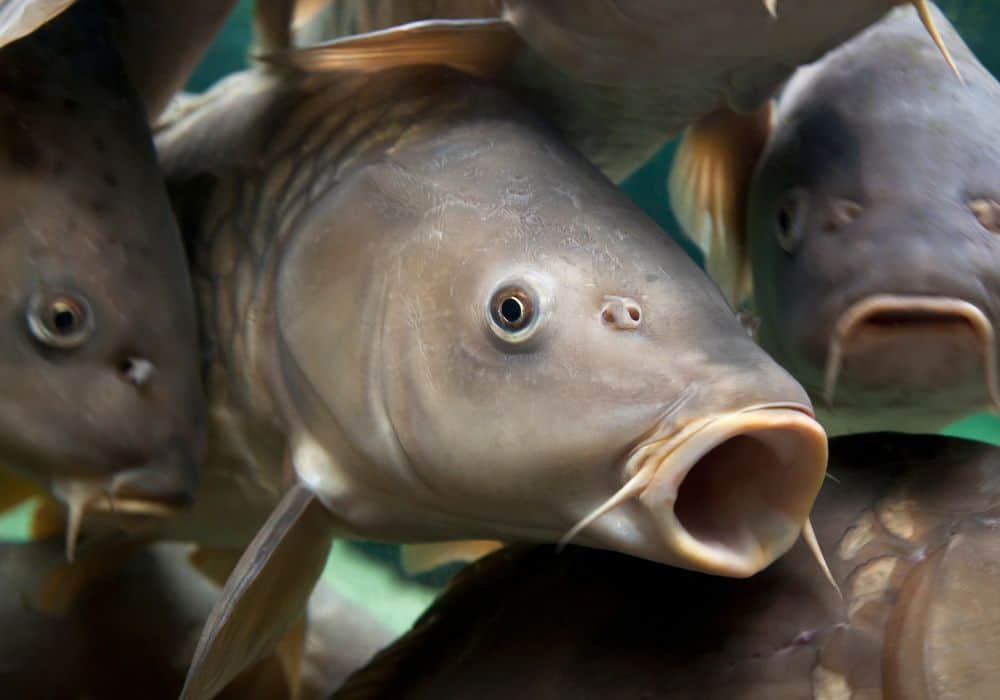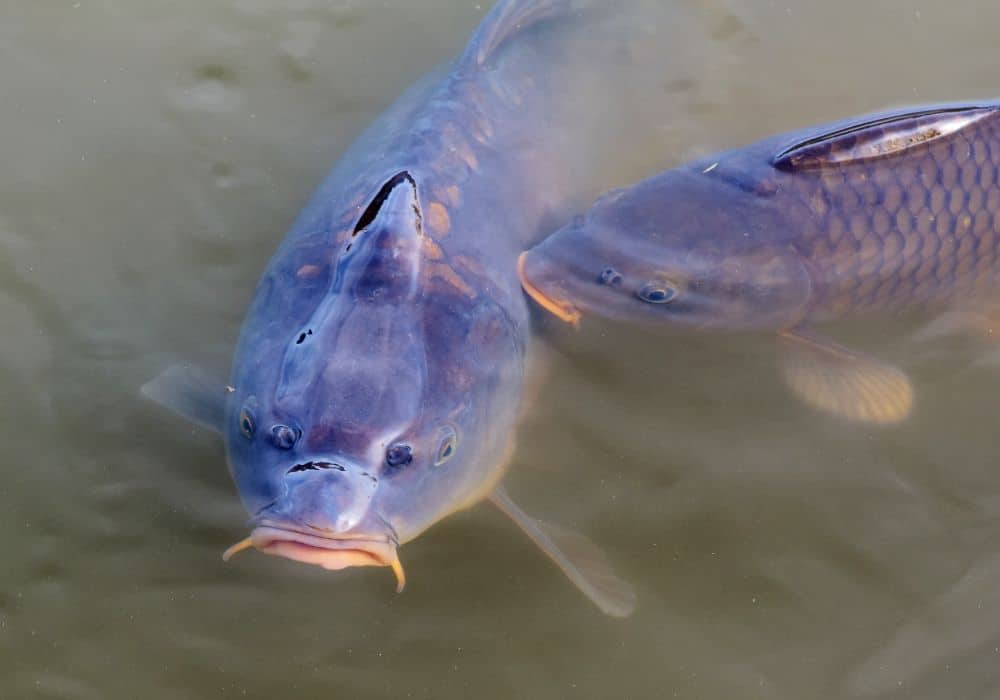Carp are fascinating creatures, popular as a fishing sport and as part of delicious meals on our plates. More recently, they’ve also become popular pets in many outdoor ponds worldwide.
Carp is a highly advanced predator too, and learning about how they survive scavenging the muddy bottoms of rivers will open your eyes to how advanced the common carp is.
Suppose you want to catch a carp yourself – you’ll need to out one important thing; what exactly do carp eat? Once you find this out, you’ll be able to lure even the most elusive carp from its muddy habitats.
Today we’ll give you all the information you need to become a seasoned carp angler. We’ll also go through how a carp feeds, giving you a better understanding of these beautiful fish.
Fast Facts about Carp
- One carp can lay over a million eggs in a year.
- Carp live in various locations, including the open ocean and freshwater places like ponds, rivers, and lakes.
- Carp have an average lifespan of 20 years.
- There are over 9 species of carp. Most species are classed as vulnerable by conservationists.
- Carp have a set of pharyngeal teeth located further down their throat and help the fish chew, crush and swallow their prey.
- Carp can ‘smell’ their food in the water using specialized antennae.
- Carp can grow to an average length of 40 to 80 cm.
- During the winter, carp go through a ‘fake hibernation,’ where they stay at the bottom of the water and stop moving to conserve energy.
- Koi are popular ornamental fish in ponds. They are a subspecies of the common carp.
- Carp is one of the most popular fish to catch in competitive fishing.
- Carp can survive in low-oxygen conditions and poor visibility.
What do carp eat?
Carp are omnivores, meaning they will eat both meat and plant-based foods. Because they live in various places, carp have access to several different types of food throughout the year.
Many carp anglers aim to use natural foods the carp enjoy eating when they make their baits.
Here’s a quick look at what precisely a carp enjoys eating:
Insects
Insects are a vital food source for carp during spring, summer, and early autumn. Carp use their wide mouths to ambush insects, preventing even the quickest from escaping.
They often feast on insects that rest on the water’s surface, including grasshoppers, spiders, and water striders. Carp can also eat many flying insects, including moths, mosquitoes, dragonflies, and damselflies, which may be resting on nearby plant life.
As bottom feeders, carp will also shift through river beds and muddy sediment in search of food. They will displace and gobble up insects like red worms and leeches as they glide across the floor.
Plant matter
Carp constantly consume various plant matter and are a great natural controller of invasive species of aquatic plants.
Their favorite plants include pondweed, hydrilla (water thyme), musk grass, and southern naiad. As well as the plant’s leaves, the carp will eat plant roots and seeds that disperse throughout the water.
If stuck for food, carp can turn to eat algae, though it’s not highly nutritious for them.
Crustaceans & Mollusks
Carp will often hunt other bottom-dwelling animals, including a variety of crustaceans. Their favorites include freshwater shrimp, crayfish, and water snails.
Crustaencs are very nutritious for carp, containing high amounts of Omega 3 and minerals like iron and zinc. The carp’s strong pharyngeal teeth can make short of any shell defense.
Carp will also happily eat mollusks; their favorite is the zebra mussels which are high in protein and known to increase the size of predator fish.
Nuts and Berries
Carp are also effective foragers and will eat various nuts and berries if they come across them. Some overhanging fruit they love includes wild strawberries, mulberries, and blackberries.
Although carp do not come across nuts in the wild, anglers have discovered they love eating peanuts and almonds and frequently use these as bait.
Do carp eat other fish?
Although carp will gladly eat fish, they are slow-moving and can’t hunt them successfully. Because their teeth are located further down in their throat, they can’t effectively chew large prey.
That said, carp have been seen to catch small fish like minnows and munch on dead carcasses. Carp is an opportunistic feeder who will happily feast on fish eggs if they stumble upon them.
How much do carp eat?
Carp are large fish, so it’s no surprise that they must consume lots of food to maintain their size. A carp is estimated to eat up to 2% of its body weight daily. However, if given a chance, carp will happily gorge on even more food than this.
Because of their size, protein is one of the most crucial nutrients for the fish to eat. For that reason, crustaceans are mainly a valuable snack. Foods that lack natural nutrition, like algae or dead plant matter, are not feasible.
Carp will often change their diet and the amount they eat depending on the weather and the water temperature they swim through. For example, in the wintertime, food is less available. The carp slows its metabolism down and will go through a pseudo-hibernation. In the warmer spring and summer months, they travel more and thus consume more.
How do carp find food?
Despite hunting in often murky, muddy water or in poor visibility, carp are incredibly effective hunters.
The primary way they find their food is thanks to two appendages known as barbels. They are located on either side of the carp’s mouth.
Barbules have many functions. Firstly, they have limited movement, which can manipulate the direction of smaller prey, allowing the carp to ambush them.
But most importantly, barbels have many taste receptors around their surface area. The carp can use these to detect specialized enzymes in the water. These can help identify nearby fish that the carp can easily catch and any food source high in nutritional value (like fish eggs or insect larvae).
They can also help keep the carp safe by detecting much larger fish that could pose a potential threat. A carp’s advanced barbule allows them to hunt during dusk when other fish are much more vulnerable to predation.
These taste receptors are also helpful in detecting dead fish, which may otherwise have sunk and submerged fully into the muddy bottom.
Finally, when all else fails, a carp can rely on its eyesight to find and ambush prey. This is usually only useful when hunting food outside the water, such as overhanging fruit or insects resting on nearby vegetation.
What is the best way to attract carp?
Carp is one of the most caught fish around America and Europe, with hundreds of competitions and clubs set up solely to catch this species.
As we’ve discussed, carp have a keen sense of underwater smell and prefer heavily scented foods.
The best carp feed for fishermen to place on their hook include:
- Boilies: These are made from the boiled paste and are often considered the best bait among anglers worldwide. Flavors include everything from mussels and fishmeal to worms and vegetables.
- Sweet corn: Speaking of vegetables, scientists have discovered carp adore eating sweet corn. Because kernels are tiny, attach them to a specialized egg hook.
- Fruit: Carp has a surprising sweet tooth for fruit and will gorge on everything from strawberries and apple slices to tomatoes.
- Bugs: A classic for a reason – earthworms and maggots are popular carp bait that is easy to attach and reel. They are especially effective in winter when insects aren’t plentiful.
- Seeds: Full of oil and essential nutrients, carp can’t resist high-quality seeds like hemp or sunflowers. Similar to sweet corn, apply an egg hook to your rod.
- Nuts: Like seeds, nuts can entice carp to hunt for high-fat foods. Some options include tiger nuts, peanuts, and almonds, which can come in the form of pellets to hook on easily.
- Dough balls: A simple dough ball made of flour is known to attract a variety of fish, including carp, trout, and bass.
- Fish oil: If your baits aren’t pulling in any winners, consider scenting them with store-bought fish oils, which will make your baits smell irresistible to hungry carp.
Conclusion
Whether it’s the sport of catching them, transforming them into a variety of delicious recipes, or simply appreciating them for the fascinating fish they are – carp are one of the most popular fish worldwide.
If you decide to catch carp and are on the hunt to reel in a whopper, we wish you the best of luck in your endeavors!


